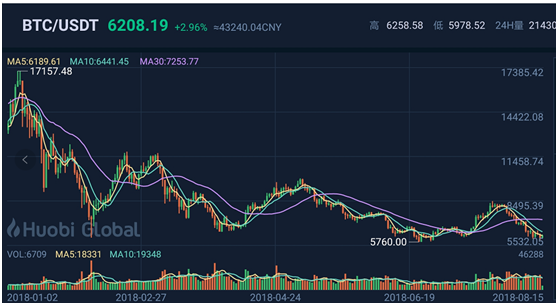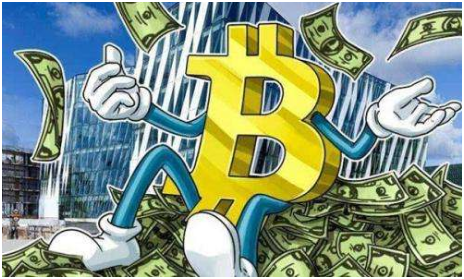Bitcoin's most complete collapse: after the crash, the surge is even more violent, will history repeat itself?
Recently the coinage is very "red", every day opens the exchange software, sees is a dazzling red. The color represents the evaporation of billions and even billions of dollars of wealth every day and the destruction of millions of investors' money.
The price of bitcoin, for example, peaked at around $20,000 in December of 2017, and fell below $6,000 yesterday, a decline of more than 70 percent, sparking panic in the industry. People outside the industry are watching the fun, lamenting the free fall of bitcoin prices and congratulating themselves for not falling into the digital currency pit. Traditional financial institutions are also making up for it, with the investment strategy team led by Sharmin mossavar-rahamani, chief investment officer of Goldman sachs, noting in the report: "we do not expect cryptocurrencies to retain their current value. In fact, cryptocurrency values are shrinking much faster than we expected. We believe that cryptocurrencies cannot fulfill the three traditional roles of money - neither as a medium of exchange, nor as a unit of measurement, nor as a store of value. Because of that, we expect cryptocurrencies to fall further in the future. ""
Is it really that simple? As an old Chinese saying goes, "if we take history as a mirror, we can know what is going on." Is bitcoin really dead? Before you make that judgment, take a look at bitcoin's previous performance.
In 2008, the global financial crisis erupted and bitcoin emerged. In order to cope with the opacity and uncontrollability of the central issue of currency, "bitcoin founder" satoshi nakamoto proposes the idea of bitcoin based on the blockchain technology model. On January 3, 2009, satoshi nakamoto scooped up 50 bitcoins in a small server in Helsinki, Finland. Since then, bitcoin has been on the currency market stage.
For a long time after the first bitcoin was born, there was no market value for it, despite the growing number of people involved in "mining," until May 21, 2010, when American programmer laszler exchanged 10,000 bitcoins for two pizzas at a market price of $30. The "most expensive pizza ever" event marked the beginning of bitcoin's gain in market value, with an initial price of $0.003, or 1.88 yuan, in pizza terms.
In November 2010, the price of a single bitcoin on Mt.Gox, the world's largest bitcoin exchange, broke through $0.50, about 167 times higher than the initial price. Recently the coinage is very "red", every day opens the exchange software, sees is a dazzling red. The color represents the evaporation of billions and even billions of dollars of wealth every day and the destruction of millions of investors' money.
The price of bitcoin, for example, peaked at around $20,000 in December of 2017, and fell below $6,000 yesterday, a decline of more than 70 percent, sparking panic in the industry. People outside the industry are watching the fun, lamenting the free fall of bitcoin prices and congratulating themselves for not falling into the digital currency pit. Traditional financial institutions are also making up for it, with the investment strategy team led by Sharmin mossavar-rahamani, chief investment officer of Goldman sachs, noting in the report: "we do not expect cryptocurrencies to retain their current value. In fact, cryptocurrency values are shrinking much faster than we expected. We believe that cryptocurrencies cannot fulfill the three traditional roles of money - neither as a medium of exchange, nor as a unit of measurement, nor as a store of value. Because of that, we expect cryptocurrencies to fall further in the future. ""
Is it really that simple? As an old Chinese saying goes, "if we take history as a mirror, we can know what is going on." Is bitcoin really dead? Before you make that judgment, take a look at bitcoin's previous performance.
In 2008, the global financial crisis erupted and bitcoin emerged. In order to cope with the opacity and uncontrollability of the central issue of currency, "bitcoin founder" satoshi nakamoto proposes the idea of bitcoin based on the blockchain technology model. On January 3, 2009, satoshi nakamoto scooped up 50 bitcoins in a small server in Helsinki, Finland. Since then, bitcoin has been on the currency market stage.
For a long time after the first bitcoin was born, there was no market value for it, despite the growing number of people involved in "mining," until May 21, 2010, when American programmer laszler exchanged 10,000 bitcoins for two pizzas at a market price of $30. The "most expensive pizza ever" event marked the beginning of bitcoin's gain in market value, with an initial price of $0.003, or 1.88 yuan, in pizza terms.
In November 2010, the price of a single bitcoin on Mt.Gox, the world's largest bitcoin exchange, broke through $0.50, about 167 times higher than the initial price.
In 2011, the rise of bitcoin did not stop. In April and June of 2011, the price of bitcoin soared from about 95 cents to 32 dollars, about 10666 times higher than the initial price. However, because of the poor liquidity of bitcoin at that time and the lack of depth in the disk trading, the price of bitcoin collapsed immediately after several sales orders, and finally stopped the rout at $2, a full 94 percent decline, drawing ridicule from mainstream financial media. This was the first time in the history of bitcoin.
After brief attention, the public eye and focus on the major economic indicators, the currency in the corner that is forgotten slowly reforming state, quietly, in the currency in 2013, breaks through the previous high of $32, then more overwhelming, to April 2013, has been rushed to $260, the price is the currency to 86666 times the original price.
Only to find the COINS mining software produced in an update to a little "fault", leading to the world's largest exchange Mt. The bigger the withdrawal business suspended the COINS, a large number of traders said, thought that the currency is to return to zero, hurry down, trying to escape the "ponzi scheme" in their heart, in a matter of days, the currency prices fell to $40, or 85%. This is the second plunge in bitcoin history.
But the crash didn't completely destroy bitcoin. As the mt.gox business resumed, the price of the cryptocurrency began to soar again, reaching $1,200 in November 2013. That price is 400,000 times the initial price of bitcoin.
But this time, the currency has finally started to attention by mainstream society, in December 2013, the central bank and other five ministries issued the notice on preventing the risks of currency, news, on the day of the currency will be halved to $600 from $1200, and then for more than 400 days of big bear market, the market a whine, until January 2015, the currency was firmly established at $150, compared with before the highest point, or 87.5%. This is the third plunge in bitcoin history.
In the following year, bitcoin experienced a huge change. The internal change was that the annual output began to shrink. The external change was influenced by events such as brexit, American election and surge of Asian investors.
2017 was a truly wild year for bitcoin, the first five months of which the price of the cryptocurrency slowly rose, reaching $2,000 by mid-may. But in June and July it started to fall again, by 45%. In September 2017, China issued the notice on preventing the financing risk of token issuance, and the Chinese market was instantly frozen. However, the bitcoin investors from Japan and South Korea continued to pour in, and the price of bitcoin kept soaring all the way to December 18, when the price reached the historical peak of usd 20,000 million, which was 6.66 million times higher than the initial price.
But the high price did not last long, and bitcoin prices began to fall rapidly after peaking, falling below $11,000 by December 31. The decline has continued to this day, with bitcoin hovering around $6,000, as described earlier, down more than 70 percent from its highs.
From the above review, it can be concluded that bitcoin is currently in the fourth wave of decline. The historical pattern was that each plunge would fall by more than 85 per cent and last longer than the next. If previous experience holds, the bear market will last at least another six months and the price will be back below $3,000. Of course, this is just a simple assumption based on the re-enactment of history. The real world tends to be more wonderful than TV series. Will history repeat itself?


Congratulations @xiaojin! You have completed the following achievement on the Steem blockchain and have been rewarded with new badge(s) :
Click on the badge to view your Board of Honor.
If you no longer want to receive notifications, reply to this comment with the word
STOPDo not miss the last post from @steemitboard: